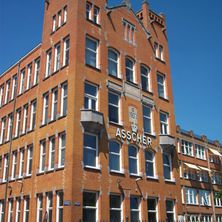

The diamond factory in the Tolstraat testifies to the large diamond industry flourishing in Amsterdam before World War 2nd. Diamond trade has been historically dominated by Sephardic Jews who had fled to the Netherlands from Spain and Portugal in the 16th and 17th centuries escaping the Inquisition. They had major international trade contacts in the areas where diamonds were being mined. In addition to the commercial aspect, the polishing operation was also largely in the hands of the Sephardic Jews. Since Jews were not allowed to join existing professional guilds and could not practice traditional crafts, they thus formed their own highly profitable industry for which there was no previous professional guild.
In the early 20th century, about 30% of Amsterdam's Jewish men and 10% of women worked in the diamond industry. In 1894, the Dutch Diamond Workers Union , the first workers union in the country, was set up to improvement the working conditions of diamond industry workers. This may have induced the move of the bulk of the diamond industry from Amsterdam to the Antwerp suburbs after 1910. The non-unionized Belgian factories polished at much lower prices.
Built in the early part of the 20th century, the Asscher diamond factory quickly achieved international reputation with the so-called "Asscher Cut", a striking octagonal cut, which became instantly popular with the clientele. In 1907, attracted by the space and lower taxes in what was then a separate town of Nieuwer Amstel, the factory moved from Nieuw Achtergracht in Amsterdam proper to Tolstraat. The architect van Arkel designed the building. The light enters through the many large windows and via the slanted roof, so that the building's interior somewhat reminds the visitor of a medieval church. From its roof the workers would admire the gorgeous views over the city.
In its heyday, Asscher employed over 750 people. It was in this building that the Cullinan, the largest rough diamond ever, was split and polished in 1908. It has since been incorporated into the crown jewels of the British royal family: the Imperial State Crown and the Imperial Scepter. Nowadays, both can be viewed at the Tower of London.